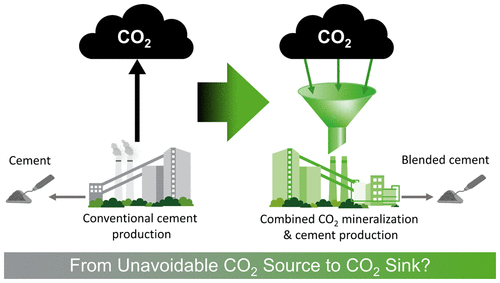当前位置:
X-MOL 学术
›
Environ. Sci. Technol.
›
论文详情
Our official English website, www.x-mol.net, welcomes your
feedback! (Note: you will need to create a separate account there.)
From Unavoidable CO2 Source to CO2 Sink? A Cement Industry Based on CO2 Mineralization
Environmental Science & Technology ( IF 10.8 ) Pub Date : 2021-03-18 , DOI: 10.1021/acs.est.0c07599 Hesam Ostovari 1 , Leonard Müller 1 , Jan Skocek 2 , André Bardow 1, 3, 4
Environmental Science & Technology ( IF 10.8 ) Pub Date : 2021-03-18 , DOI: 10.1021/acs.est.0c07599 Hesam Ostovari 1 , Leonard Müller 1 , Jan Skocek 2 , André Bardow 1, 3, 4
Affiliation

|
The cement industry emits 7% of the global anthropogenic greenhouse gas (GHG) emissions. Reducing the GHG emissions of the cement industry is challenging since cement production stoichiometrically generates CO2 during calcination of limestone. In this work, we propose a pathway towards a carbon-neutral cement industry using CO2 mineralization. CO2 mineralization converts CO2 into a thermodynamically stable solid and byproducts that can potentially substitute cement. Hence, CO2 mineralization could reduce the carbon footprint of the cement industry via two mechanisms: (1) capturing and storing CO2 from the flue gas of the cement plant, and (2) reducing clinker usage by substituting cement. However, CO2 mineralization also generates GHG emissions due to the energy required for overcoming the slow reaction kinetics. We, therefore, analyze the carbon footprint of the combined CO2 mineralization and cement production based on life cycle assessment. Our results show that combined CO2 mineralization and cement production using today’s energy mix could reduce the carbon footprint of the cement industry by 44% or even up to 85% considering the theoretical potential. Low-carbon energy or higher blending of mineralization products in cement could enable production of carbon-neutral blended cement. With direct air capture, the blended cement could even become carbon-negative. Thus, our results suggest that developing processes and products for combined CO2 mineralization and cement production could transform the cement industry from an unavoidable CO2 source to a CO2 sink.
中文翻译:

从不可避免的CO 2源到CO 2汇?基于CO 2矿化的水泥工业
水泥行业的排放量占全球人为温室气体(GHG)排放量的7%。减少水泥工业的温室气体排放是具有挑战性的,因为水泥生产在石灰石煅烧过程中化学计量地产生了CO 2。在这项工作中,我们提出了使用CO 2矿化的碳中和水泥工业的途径。CO 2矿化作用将CO 2转化为热力学稳定的固体和副产物,可以潜在地替代水泥。因此,CO 2矿化可以通过两种机制减少水泥行业的碳足迹:(1)捕获和储存CO 2(2)通过替代水泥减少熟料的使用。然而,由于克服缓慢的反应动力学所需的能量,CO 2矿化也产生了温室气体排放。因此,我们基于生命周期评估分析了CO 2矿化和水泥生产相结合的碳足迹。我们的结果表明,合并的CO 2考虑到理论潜力,使用当今的能源组合进行矿化和水泥生产可以使水泥行业的碳足迹减少44%,甚至减少85%。低碳能源或水泥中矿化产品的更高掺合量可以实现碳中和的掺合水泥的生产。通过直接收集空气,混合的水泥甚至可以变成负碳。因此,我们的结果表明,开发将CO 2矿化和水泥生产相结合的工艺和产品可以将水泥行业从不可避免的CO 2来源转变为CO 2汇。
更新日期:2021-04-20
中文翻译:

从不可避免的CO 2源到CO 2汇?基于CO 2矿化的水泥工业
水泥行业的排放量占全球人为温室气体(GHG)排放量的7%。减少水泥工业的温室气体排放是具有挑战性的,因为水泥生产在石灰石煅烧过程中化学计量地产生了CO 2。在这项工作中,我们提出了使用CO 2矿化的碳中和水泥工业的途径。CO 2矿化作用将CO 2转化为热力学稳定的固体和副产物,可以潜在地替代水泥。因此,CO 2矿化可以通过两种机制减少水泥行业的碳足迹:(1)捕获和储存CO 2(2)通过替代水泥减少熟料的使用。然而,由于克服缓慢的反应动力学所需的能量,CO 2矿化也产生了温室气体排放。因此,我们基于生命周期评估分析了CO 2矿化和水泥生产相结合的碳足迹。我们的结果表明,合并的CO 2考虑到理论潜力,使用当今的能源组合进行矿化和水泥生产可以使水泥行业的碳足迹减少44%,甚至减少85%。低碳能源或水泥中矿化产品的更高掺合量可以实现碳中和的掺合水泥的生产。通过直接收集空气,混合的水泥甚至可以变成负碳。因此,我们的结果表明,开发将CO 2矿化和水泥生产相结合的工艺和产品可以将水泥行业从不可避免的CO 2来源转变为CO 2汇。































 京公网安备 11010802027423号
京公网安备 11010802027423号